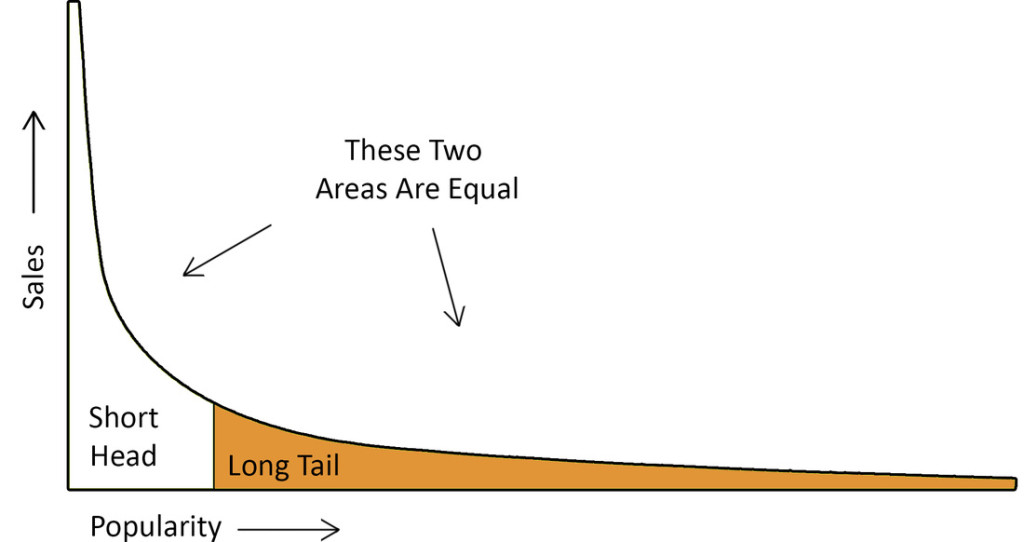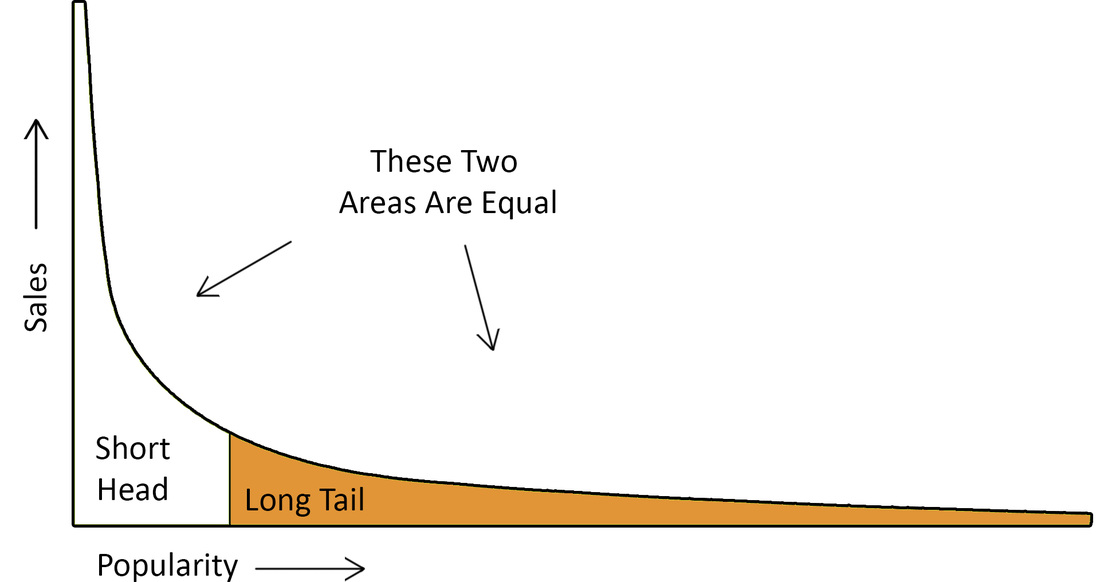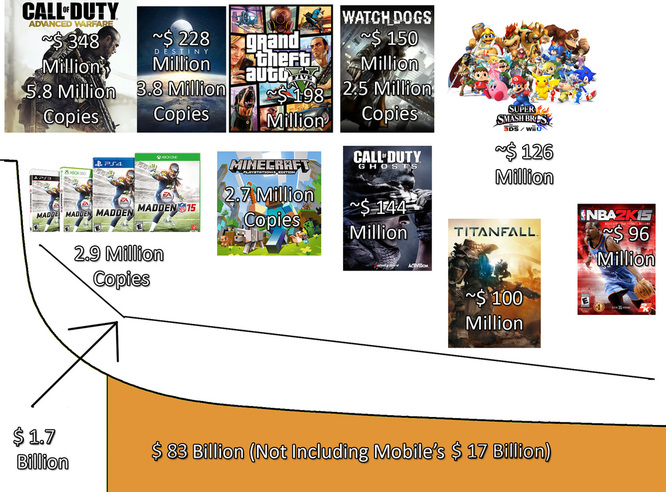Times are Changing...

|
|
In 2014, the ten top best selling Video Games generated about $1.7 Billion in revenue across all platforms. Sounds like an awful amount of money, right? Well, what if I told you that the nearly two billion dollars described was only 1/50th of the estimated total sales for the entire games industry?
$100 Billion dollars, that is the number that Video Games sales as a whole are expected to have reached last year. Meaning over $90 billion was earned by games that most people have never heard of, let alone played. I'm not only here to talk about how this is possible, but also how publishers could use it to their advantage. |
"Hit" Culture is Dying, and That's okay.
It all comes down to something called “The Long Tail”. This is when the total sum of less popular products match or outsell the more commonly praised products in their respected industry. Let’s look at an example of exactly what I mean.

This example is for the music industry, but the basic idea applies to any industry. The further to the right of these Long Tail graphs, the less popular a product is and therefore the less sales it receives. Although there are many unpopular songs, the total sales (represented by the red and yellow areas under the graph) are equal. Many of you most likely believe that by “Long Tail” I speak about the idea that the sales for a game start high but quickly shrink. And while that one aspect of the Long Tail Theory is covered beautifully in this article, it is not what I, nor many readers focused on while reading Chris Anderson’s original book on the subject. What Doucet’s article explains is how sales for one product start high, but create a Long Tail as time goes on. Anderson however, describes the Long Tail as showing how products that have a lower demand are actually more valuable to the distributor as long as they are made accessible to the consumer.
Yeah that’s quite a mouthful, and we’ll take a look at exactly what each part of Anderson's definition means later.
So to keep us all on the same page, keep the idea in mind that products with high demand can and sell just as much as all the products with low demand, as shown in the second graph below.
Long Tails Are Becoming the Greater Area.
So how does this apply to our Industry? Lets take another look at the "top 10 sellers of 2014" example from earlier. With The Video Game industry being as young as it is, our Long Tail Graphs have started to grow one sided much faster. In addition, last year (2014) we had a laundry list of "Hit" games that disappointed the general public, making even more room for the Long Tail to grow.
An Easier Way to Purchase Product
|
Digital Distribution has changed the way we consume all of our media. With it, publishers and retailers can offer more choice to consumers. The method of easily obtaining our entertainment is what finishes the formula Anderson set forth in his book, “Make the product easy to find and easy to buy.”
So why does digital media give the consumer so much more choice than traditional retailers? Well a local GameStop only has so much shelf space
 and they need to reserve it for games that they know will sell, games in the top 10 or top twenty on the graph. Anything less popular and more niche runs a much higher risk of never being purchased, which is bad for business. Why risk wasting such valuable shelf space on something no one in the local area might enjoy? and they need to reserve it for games that they know will sell, games in the top 10 or top twenty on the graph. Anything less popular and more niche runs a much higher risk of never being purchased, which is bad for business. Why risk wasting such valuable shelf space on something no one in the local area might enjoy? |
|
|
With a distribution system like Steam, your shelf space is infinite and the more niche products you can offer to your customers, the more games you can sell from the long tail, increasing its impact even more. Suddenly you're not only liberated from your shelf space limitation, but also your local neighborhood limitation, where the number of niche tastes is significantly less than the number of niche tastes around the world.
The main issue with something like this, as we've all seen with Steam lately, is that if left unchecked, your store and market will become flooded with products that brings down the prestige of your service. When you see the latest hot title next to baby's first video game, it defaces it's value in a sense. |
A Change In Product Location, And Now A Change in Products
|
Plan and make one large game with a 5+ year development cycle, and while a good chunk of your team works on that, have your other teams in other cities, countries, all focus on making smaller games than appeal to a niche audience. Games like Gat Outa Hell, Blood Dragon, Child of Light, Grow Home, Infamous: First Light are all great steps in the right direction and have shown that the long tail can reach out to niche audiences and land a hit! Blood Dragon in particular is a game we would have never seen without the long tail, and it certainly wouldn't have seen the success it did without it either.
Now we all know big publishers don't want to risk money on these niche products, it's because they don't know if a market exists for it, and that's also okay. Not everyone is going to want these games, but they are much cheaper to make because of the smaller scope and ability to re-use some assets from pre-existing games. There’s a lot of merit to be had from the old saying, no risk no reward. And while risking developing and marketing for the Long-Tail could result in said game never finding an audience, when the risk pays off it’s healthy for business and for the industry as a whole. Hell, a small game might find such a strong audience that it demands larger future sequels, and could spawn it’s own franchise, or even genres.
|
Invisible Inc. (shown above) is a strange blend of Stealth and Turn Based Strategy. This is another example of game that would most likely have not seen the light of day if the developers (Klei) avoided making niche products. Klei also found success in their previous Long Tail orientated titles, Mark of the Ninja and Don't Starve.
|
Moving Forward: Embrace the Changes Coming
|
|
I'd be willing to bet a lot that I'm not alone in the recent frustrations with many of the methods publishers have been attempting to avoid change and draw out big hits as long as possible. From season passes, on disc DLC, in game micro-transactions, collectors editions, definitive editions, pre-order bonuses, and other negative buzz words.
All this stuff does, is attempt to patch up a giant sinking ship, when instead you should be getting on the smaller and safer life raft.
Instead of focusing developers on small monetary practices to incorporate into their games, which I doubt they are passionate about in the first place, let developers explore some of the weird ideas for games that they have. Throw a programmer or two with a team of artists and make a wacky game prototype and see if the rest of the team has fun with it. It's in this way publishers can utilize the thousands of talented people at their finger tips, while coming up with small ideas for small products, with small costs, for a small audience. And like the graphs themselves, the money won't be huge for each game, but make enough of them for more niche markets, and I think we can see a new era in gaming.
|










One comment